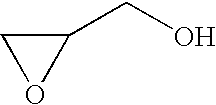Surface-treating agent composition and process for producing the same
a technology of surface treatment agent and composition, which is applied in the field of perfluoroalkyl compounds, can solve the problems of inability to use perfluoropolyether, film cannot be sufficiently fixed to the surface, and the type of compatible monomers is limited
- Summary
- Abstract
- Description
- Claims
- Application Information
AI Technical Summary
Benefits of technology
Problems solved by technology
Method used
Image
Examples
example 1
[0133] Preparation of 50 wt % Solution of Perfluoropolyether Urethane Acrylate Composition (1) in HCFC-225:
[0134] In a 1 L three-necked flask equipped with a dropping funnel, a condenser, a thermometer and a stirrer, SUMIDUR N3300 (a cyclic trimer of hexamethylene diisocyanate, manufactured by Sumitomo Bayer Urethane Co., Ltd., an NCO group content: 21.9%) (57 g) was dissolved in HCFC-225 (165 g), dibutyltin dilaurate (a first grade agent manufactured by Wako Pure Chemical Industries, Ltd.) (0.4 g) was added, a solution of DEMNUM (a PFPE monoalcohol which is identified as the formula: CF.sub.3CF.sub.2O--(CF.sub.2CF.sub.2CF.sub.2O).sub.10.9--CF.sub.2CF.sub.2-CH.sub.2OH and purity: 86.9% by .sup.19F-NMR and 1H-NMR, manufactured by Daikin Industries, Ltd.) (244 g) dissolved in HCFC-225 (160 g) was dropwise added over 4.5 hours in air at room temperature with stirring, and the mixture was stirred for 6 hours. The mixture was warmed to 40 to 45.degree. C., hydroxyethyl acrylate (24.4 g) ...
example 2
[0135] Preparation of 50 wt % Solution of Perfluoropolyether Urethane Acrylate Composition (2) in HCFC-225
[0136] In a 2 L three-necked flask equipped with a dropping funnel, a condenser, a thermometer and a stirrer, SUMIDUR N3300 (a cyclic trimer of hexamethylene diisocyanate, manufactured by Sumitomo Bayer Urethane Co., Ltd., an NCO group content: 21.9%) (144 g) was dissolved in HCFC-225 (200 g), dibutyltin dilaurate (a first grade agent manufactured by Wako Pure Chemical Industries, Ltd.) (0.2 g) was added, a solution of DEMNUM (a PFPE monoalcohol which is identified as the formula: CF.sub.3CF.sub.2O--(CF.sub.2CF.sub.2CF.sub.2O).sub.10.9--CF.sub.2CF.sub.2-CH.sub.2OH by .sup.19F-NMR and 1H-NMR, manufactured by Daikin Industries, Ltd.) (202 g) dissolved in HCFC-225 (300 g) was dropwise added over 4.5 hours in air at room temperature with stirring, and the mixture was stirred for 6 hours. The mixture was warmed to 30 to 40.degree. C., hydroxyethyl acrylate (96 g) was dropwise added o...
example 3
[0137] Isolation of Perfluoropolyether Urethane Acrylate Composition (2):
[0138] In a 1 L three-necked round-bottom flask equipped with a thermometer, a stirrer and a reduced pressure distillation apparatus, hexane (200 g) was added to the 50 wt % solution (400 g) of perfluoropolyether urethane acrylate composition (2) in HCFC-225 prepared in Example 2 and the mixture was kept standing for 12 hours. An upper layer was separated off, the precipitate was dissolved by adding acetone (500 g) and p-tert-butyl catechol (0.5 g) with stirring. This solution was warmed to 30 to 40.degree. C. at reduced pressure for the purpose of distilling off acetone to give a perfluoropolyether urethane acrylate composition (2) (187 g).
PUM
| Property | Measurement | Unit |
|---|---|---|
| wt % | aaaaa | aaaaa |
| length | aaaaa | aaaaa |
| molar ratio | aaaaa | aaaaa |
Abstract
Description
Claims
Application Information
 Login to View More
Login to View More - R&D
- Intellectual Property
- Life Sciences
- Materials
- Tech Scout
- Unparalleled Data Quality
- Higher Quality Content
- 60% Fewer Hallucinations
Browse by: Latest US Patents, China's latest patents, Technical Efficacy Thesaurus, Application Domain, Technology Topic, Popular Technical Reports.
© 2025 PatSnap. All rights reserved.Legal|Privacy policy|Modern Slavery Act Transparency Statement|Sitemap|About US| Contact US: help@patsnap.com



